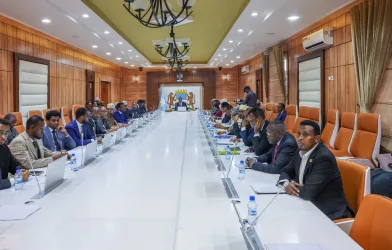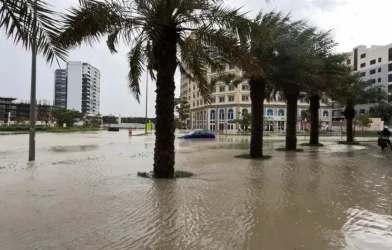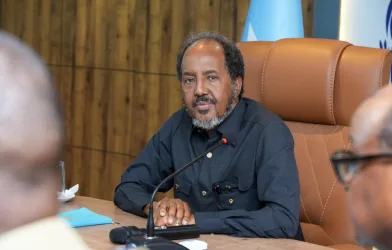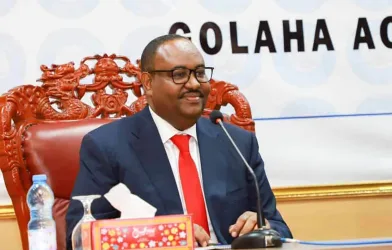 By Faysal Abdikarim:-
By Faysal Abdikarim:-
The recent Kampala bombing claimed by Alshabaab, Somalia’s notorious Islamist insurgents fighting the government, has left alarm bells ringing in the troubled Horn of Africa. The nightmare of Alshabaab posing regional threat, and their ability to strike its neighbours or beyond has become more visible. The bombing followed several warnings by Alshabaab of targeting Kampala and Bujumbura for their contribution to the African Union Peacekeeping Mission (AMISOM). Both Uganda and Burundi make up the 6,000 African peacekeepers currently protecting the government of President Sheikh Sharif in Mogadishu but fall short of 8000 peacekeepers approved by the AU in 2007 to beef up the security of Transitional Government of Somalia.
Alshabaab are increasingly gaining power in Somalia fighting government forces, the AU peacekeepers in Mogadishu and government-allied militias in central regions of Somalia. They also occasionally clash with Hizbul Islam, another insurgent group headed by Sheikh Hassan Dahir, once-spiritual father of all Islamic Courts – which Alshabaab belonged to- that briefly took over Mogadishu in 2006 before they were ousted by Ethiopian troops with the support of US government. On Sunday, Alshabaab-allied militia attacked Puntland State, in the North East of Somalia. The government forces defeated the militants but the attack signalled that Alshabaab can extend attacks to any part of the country but does not necessarily mean they can take over the state. Assassinations against government officials, security members have been on increase in Puntland. As a result, the administration started to deport internally displaced people originated from the South, a step that is not likely to prove any success. UNHCR has expressed concern over the crack down of Somali refugee in Kenya and Puntland State in the aftermath of Kampala bombing over security grounds.
The overstretched AMISOM troops protect key places in the capital, the presidential palace, the airport and the port. The last two are the main revenue sources that provide subsistence to the beleaguered government. Despite attempts to stay away from the conflict, the peacekeepers were finally drawn into the conflict by Alshabaab. Their hit-and-run attacks have left the peacekeepers no option but to fight the insurgents alongside government forces, even if that means shelling civilian populated areas with motors such as Suuq Bakaara. In April, Human Rights Watch[1] accused government forces, Alshabaab insurgents and AMISOM of indiscriminate attacks and shelling civilian populated areas. Both the United Nations and the African Union rebuffed the report as exaggerated and baseless[2]. However, AU internal reports reviewed by Associate Press in July have substantiated the HRW’s reports that war crimes were committed by AMISOM troops in Mogadishu.[3]
Such negative engagement plays against the peacekeepers and spoils their image within the public which its support is crucial in defeating Alshabaab. For many in Southern Somalia, peacekeeping mission or foreign military intervention are synonyms for indiscriminate killing of civilians and mass displacement. But no government can work or survive without foreign military assistance, particularly in the current stage.
The failure of United Nations intervention in 1992, followed by collapse of serial peace talks between Somali factions has questioned whether the country needs peacekeeping or peace enforcement. The United Nations has declined to send peacekeepers to Somalia several times citing the lack of peace in the country to keep. However, since 2007 they have lent support to African mission in Somalia. The UN feels if they go to Somalia, their charter will be at stake; they will have to engage war with Islamist fighters and the peacekeeping mission will eventually turn into bloody counter-terrorism. In addition, minimizing civilian death in urban warfare cannot materialize without massive displacement of civilians and in a country without government institutions providing essential services; shelter, food, clean water, primary health to refugee, such displacement would translate into massive deaths. Maternal and child death rates are high in internally displaced camps. Ramshackle hospitals in the country cannot treat the large number of civilians wounded in the fighting. Upon arrival, Ugandan peacekeepers opened temporary hospitals to treat civilians in the area they control. This has gained some public approval and support to the mission but with their long engagement, the unpredictable outcome, and indiscriminate attacks that support is dying away.
After Kampala bombing, the Intergovernmental Authority on Development (IGAD) called for additional peacekeepers for Somalia with UN taking the largest stake. Neighbouring countries again offered to contribute troops despite official ban on their contribution to Somalia. IGAD issued similar calls in the past but did not have any effect. This call, however, is now louder and more serious than any other appeal. Bombing in Uganda, a country that shares no border with Somalia, was a strong message to those bordering the troubled country; Kenya, Ethiopia and Djibouti.
The African Union Summit in Kampala has also stressed the need to increase current number of peacekeepers in Somalia and urged member states to deploy troops. Djibouti, Guinea, and Senegal said to be sending peacekeepers to share the burden with Uganda and Burundi. But it is not yet clear when it will materialize. In 2007, several African states offered the same pledge but only Uganda and Burundi lived up to their promises. At this time, the AU wants to be serious and keep its word because Musevani, whose country is paying the price of contribution, would not accept anything shorter than deployment of multi-national forces. His troops are stuck between their obligations to act upon International Humanitarian law; protect civilians and to secure Transitional Institutions in Somalia, which they can hardly deal with similar to that of NATO’s allied forces in Afghanistan. NATO with its strong manpower, finance and advanced technology is battling the Taliban for nearly a decade with no victory in sight. The difference between NATO and AMISIOM despite fighting the same people is that the later has a peacekeeping mandate, and less powerful.
Before massing up thousands of troops into Somalia, the International Community needs to review their mandate, set up sufficient mechanisms to protect civilians, and hold the government to accountability to insure that funds are used properly. More funds to a corrupt regime will not improve the situation, but will prolong the presence of foreign troops there. Civilians’ deaths, poverty and human rights abuses will ultimately favour insurgency.
The writer is Somali journalist and can be reached at journo20@gmail.com
[1] “Harsh War, Harsh Peace: Abuses by al-Shabaab, the Transitional Federal Government, and AMISOM in Somalia†Human Rights Watch, 19 April 2010.
[2] “African Union denies illegal fighting in Somalia† Reuters, 28 April 2010.
[3] “AU troops harming Somali civilians†Associated Press, 22 July 2010.







